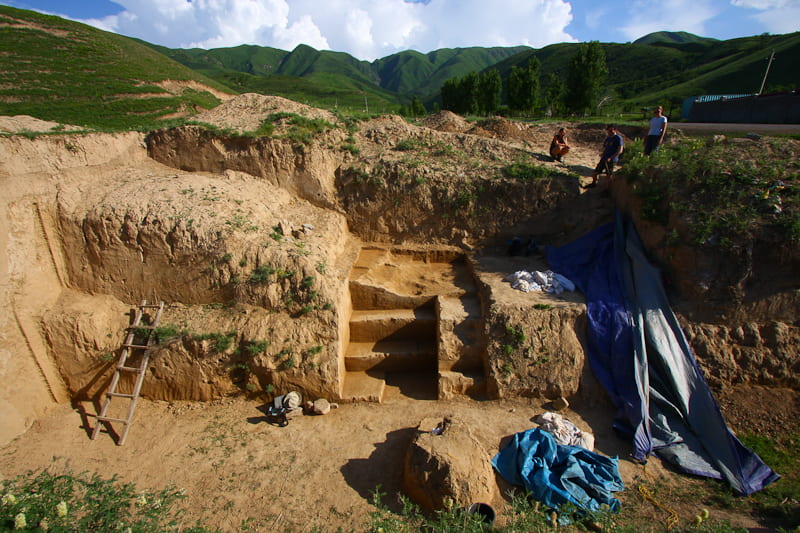PALAEOSILKROAD
In September 2016, I was awarded a five-year European Research Council Starting Grant of 1.5 M euros for a large-scale survey and fieldwork project aimed at reconstructing human settlement in relation to climate change in Central Asia during the last glacial cycle. The project aims to discover Paleolithic sites in the Inner Asian Mountain Corridor and test the hypothesis that Pleistocene dispersals correlated with climatic pulses during the last Glacial Cycle (ca. 110 000 – 15 000 years ago). We documented 95 new karstic caves and rockshelters in the Qaratau, Tian Shan, and Dzhungarian Alatau mountains [Iovita et al. 2020; Cuthbertson et al., 2021], as long as a suite of other open air sites [Namen et al., 2022, 2024]. Moreover, we explored the link between geological factors and the preservation of sites [Varis et al., 2022].

Last Glacial Maximum adaptations at Aqtogai Cave
Starting in 2024, we have begun excavating Aqtogai Cave, in collaboration with the National Museum of the Republic of Kazakhstan, Nazarbayev University, and the Jambyl Province Museum in Taraz. Here, we discovered a unique human occupation during the Last Glacial Maximum (LGM) cold period – in most of the region, sites are abandoned during this time. We’re trying to find out if people survived here because they had developed special cultural adaptations or because the climate was locally milder.

Early Upper Paleolithic in the Tian Shan (Kazakhstan)
In May of 2013, I started a cooperation with the Prof. Zhaken Taimagambetov (Kazakh National University (KazNU) in Almaty and National Museum of the Republic of Kazakhstan, Astana), in view of a long-term archaeological study of the piedmonts in Kazakhstan. During our first two field seasons, we took luminescence dating samples from two important early Upper Paleolithic sites, Valikhanova and Maibulaq (see Fitzsimmons et al. (2017)), and re-studied the lithic collections from Maibulak at the Paleolithic Museum of the university in Almaty. In the summer of 2015, in collaboration with G. Bekseitov and E. Ospanov (KazNU) we undertook the first small-scale excavations at Maibulaq, looking to correlate the two trenches that had already been dug in the early 2000s, and to obtain samples for paleoenvironmental proxies. The open-air multi-layer loess site is particularly interesting because of the presence of up to 28 fire features and early ‘true’ bladelet technology noted in the earlier excavations. Excavations were carried out in 2017 under the sponsorship of the Leakey Foundation and a paper on the reinterpretation of the site is in preparation.
 .
.
Karst and loess in the Lower Danube steppe (Romania)
The Lower Danube Survey for Paleolithic Sites Project (LoDanS) aimed to investigate the Lower Danube as a corridor for movements into and out of Europe during the Middle to Late Pleistocene. The team brought together a number of experts in Paleolithic archaeology, geomorphology, geochronology and environmental magnetism, as well as geophysics, to develop a comprehensive cutting-edge methodology for systematically surveying deeply buried Paleolithic sites in the loess steppe. In our three seasons 2010-2012, we discovered and excavated Romania’s first Lower Paleolithic site [Iovita et al. 2012], and identified several other new sites for further investigation [Iovita et al. 2014; Fitzsimmons et al. 2020]. Among the interesting preliminary results of this research is the similarity of economic behavior relating to stone-extraction over long periods of time, from the Lower to the Upper Paleolithic, periods which would be impossible to distinguish simply based on technology or typology at these extraction sites.
One major focus of the 2012 season was documenting the impact of past volcanic eruptions on hominin occupation in the region [Fitzsimmons et al. 2013], particularly with regard to the arrival of the first modern humans into Europe. The research project also served as an accredited course at the University of Mainz, with 20 Bachelor and Master students participating.
References
Iovita, R., Varis, A., Namen, A., Cuthbertson, P., Taimagambetov, Z., Miller, C.E., 2020. In search of a Paleolithic Silk Road in Kazakhstan. Quaternary International. doi:10.1016/j.quaint.2020.02.023
Fitzsimmons, K.E., Iovita, R., Sprafke, T., Glantz, M., Talamo, S., Horton, K., Beeton, T., Alipova, S., Bekseitov, G., Ospanov, Y., Deom, J.-M., Sala, R., Taimagambetov, Z., 2017. A chronological framework connecting the early Upper Palaeolithic across the Central Asian piedmont. Journal of Human Evolution 113, 107–126. doi:10.1016/j.jhevol.2017.07.006
Fitzsimmons, K.E., Sprafke, T., Zielhofer, C., Günter, C., Deom, J.-M., Sala, R., Iovita, R., 2018. Loess accumulation in the Tian Shan piedmont: Implications for palaeoenvironmental change in arid Central Asia. Quaternary International, 469A 30–43. doi:10.1016/j.quaint.2016.07.041
Fitzsimmons, KE, Hambach, U, Veres, D Iovita, R 2013. The Campanian Ignimbrite eruption: new data on volcanic ash dispersal and its potential impact on human evolution. PLoS ONE 8(6): e65839. doi:10.1371/journal.pone.0065839.
Iovita, R., Fitzsimmons, KE, Dobos, A, Hambach, U, Hilgers, A, Zander, A 2012. Dealul Guran: evidence of Lower Paleolithic occupation of the southeast European loess steppe. Antiquity 86(334):973-989. PDF
Iovita, R., A. Dobos, K. E. Fitzsimmons, M. Probst, U. Hambach, M. Robu, M. Vlaicu, and A. Petculescu 2014. Geoarchaeological prospection in the loess steppe: preliminary results from the Lower Danube Survey for Paleolithic Sites (LoDanS). Quatern Int. doi:10.1016/j.quaint.2013.05.018



